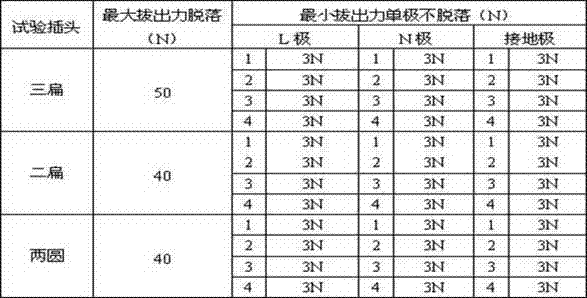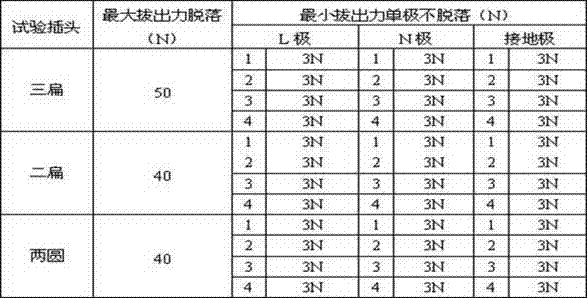Low-cost elastic brass alloy
A brass alloy, low-cost technology, applied in the field of low-cost elastic brass alloy, can solve the problem of high cost of elastic brass alloy, and achieve the effects of easy processing and simple preparation process
- Summary
- Abstract
- Description
- Claims
- Application Information
AI Technical Summary
Problems solved by technology
Method used
Image
Examples
Embodiment 1
[0014] The raw materials are 69.58% by weight of Cu, 25.75% by weight of Zn, 3.56% by weight of Al, 0.59% by weight of Ni, 0.41% by weight of Mn, and the balance is the proportion of unavoidable impurities. It is melted in a 50Kg intermediate frequency induction furnace, the melting temperature is 1100-1250°C, and the pouring temperature is 1080-1150°C. Iron mold casting, the ingot size is 60mm (thickness) × 120mm (width) × 450mm (length). The size of the ingot after face milling is 48mm (thickness) x 120mm (width) x 450mm (length). Then it is prepared according to the process of hot rolling-rough rolling-annealing-intermediate rolling-annealing-pre-finishing rolling-annealing-pickling-finishing rolling. The face-milled ingot is first heated in a walking furnace for 60-120 minutes at a temperature of 750-850°C, and then rolled into a 3.5mm-thick slab by a φ305 two-roller hot rolling mill. Rough rolling and intermediate rolling are both rolled by φ250×350 four-high rolling mi...
Embodiment 2
[0022] The raw materials are 71.52% by weight of Cu, 23.89% by weight of Zn, 3.37% by weight of Al, 0.57% by weight of Ni, 0.53% by weight of Mn, and the balance is the proportion of unavoidable impurities. It is melted in a 50Kg intermediate frequency induction furnace, the melting temperature is 1100-1250°C, and the pouring temperature is 1080-1150°C. Iron mold casting, the ingot size is 60mm (thickness) × 120mm (width) × 450mm (length). The size of the ingot after face milling is 48mm (thickness) x 120mm (width) x 450mm (length). Then it is prepared according to the process of hot rolling-rough rolling-annealing-intermediate rolling-annealing-pre-finishing rolling-annealing-pickling-finishing rolling. The face-milled ingot is first heated in a walking furnace for 60-120 minutes at a temperature of 750-850°C, and then rolled into a 3.5mm-thick slab by a φ305 two-roller hot rolling mill. Rough rolling and intermediate rolling are both rolled by φ250×350 four-high rolling mi...
Embodiment 3
[0030] The raw materials are 71.61% by weight of Cu, 23.7% by weight of Zn, 3.37% by weight of Al, 0.53% by weight of Ni, 0.28% by weight of Mn, and the balance is the proportion of unavoidable impurities. It is melted in a 50Kg intermediate frequency induction furnace, the melting temperature is 1100-1250°C, and the pouring temperature is 1080-1150°C. Iron mold casting, the ingot size is 60mm (thickness) × 120mm (width) × 450mm (length). The size of the ingot after face milling is 48mm (thickness) x 120mm (width) x 450mm (length). Then it is prepared according to the process of hot rolling-rough rolling-annealing-intermediate rolling-annealing-pre-finishing rolling-annealing-pickling-finishing rolling. The face-milled ingot is first heated in a walking furnace for 60-120 minutes at a temperature of 750-850°C, and then rolled into a 3.5mm-thick slab by a φ305 two-roller hot rolling mill. Rough rolling and intermediate rolling are both rolled by φ250×350 four-high rolling mil...
PUM
| Property | Measurement | Unit |
|---|---|---|
| Elastic modulus | aaaaa | aaaaa |
Abstract
Description
Claims
Application Information
 Login to View More
Login to View More - R&D
- Intellectual Property
- Life Sciences
- Materials
- Tech Scout
- Unparalleled Data Quality
- Higher Quality Content
- 60% Fewer Hallucinations
Browse by: Latest US Patents, China's latest patents, Technical Efficacy Thesaurus, Application Domain, Technology Topic, Popular Technical Reports.
© 2025 PatSnap. All rights reserved.Legal|Privacy policy|Modern Slavery Act Transparency Statement|Sitemap|About US| Contact US: help@patsnap.com



